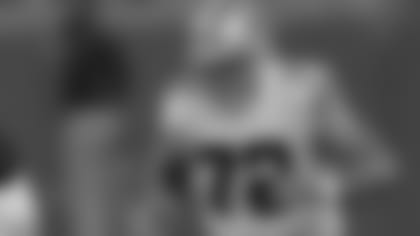Count me as one of those so-called experts that was beyond shocked at the selection when Jerry Jones traded back in the 2013 NFL Draft and selected Travis Frederick in the first round. In the days leading up to the draft, I thought center was a position of need, but I was more willing to address it more likely in the third or fourth rounds.
But to their credit, the Cowboys had a second round grade on Frederick and once they got past the 18thpick of the draft, they were looking at second round players. Once they dropped to 31, their intention was clear.
For Jason Garrett, Frederick was a day one starter and he never looked back. For a rookie, there was a calmness to his game. It was rare that he looked rattled, confused or out of sorts in his play. From his first snap in rookie minicamp, you could tell that this job would not be too big for him. He was confident and composed making line calls and it gave the offensive line a stable player inside.
There was no question about the mental makeup of Frederick coming out of Wisconsin but there were concerns about the physical ones. On college film, he wasn't always playing with power or strength and there were games where he struggled to make that reach block or get up on the second level to handle linebackers. I struggled with his inability to play on his feet and I thought there were balance issues.
Where Frederick proved me wrong in his play throughout the season was no matter if he was playing against a true nose, shade or uncovered, he was able to adjust and secure his blocks. I felt very early in the season, his meeting with Kansas City's Dontari Poe was a real eye opener for him. Here was a player that was 343 pounds that played with power and extreme quickness. It was going to be an all day struggle for Frederick, and it was. Poe is a pain to deal with in the running game and even more of a problem when he rushes the passer. Poe had two sacks that day and it was a learning experience that Frederick would not forget.
As the season wore on, Frederick did a much better job of handling those defenses that played with a 3-4 front. He was much more prepared against the Chargers, Redskins and Eagles in the following weeks. In his last three weeks of the season, he was outstanding against those odd front of the Packers, Redskins and Eagles.
There were days where he wasn't perfect, but when it came to his assignments and helping across the pocket, he was on his game.
In looking back at the 2012 season, the area of this Cowboys offensive line that appeared to have the biggest issues was with its guard play. There were health issues and inconsistent play that put this group in some bad positions. Nate Livings wasn't the answer at left guard and there was something that needed to be done there before the 2013 season. On the night of the 2012 NFL Draft, Jerry Jones spoke to the media in glee about the free agent signing of Ronald Leary, a tackle out of Memphis that on tape had some nice traits but he also had a knee condition that caused him to go undrafted. The projection of Leary to guard was an interesting one because he had only played the position one time in his career.
Leary spent his rookie season on the practice squad then later was called up to the varsity for the final two games of the season. Where Leary was able to develop his craft was working on the scout team each day against Josh Brent, Jay Ratliff and Jason Hatcher. With Livings struggling with his health during minicamps and OTA's, Leary was put in the lineup and showed the coaches enough to take a gamble and pair him with Tyron Smith and Travis Frederick. Smith was only in his 3rd season, Leary basically a rookie starter experience wise and Frederick in his first season.
Where Leary excelled was in his run blocking. You could see in the zone scheme when the ball went to that left side behind him and Smith, that there were going to be positive yards. There is upper and lower body power in Leary's game. Where there were struggles was in pass protection when it came to adjusting to games upfront and the linebacker blitzes. His biggest issue was how quickly he was able to see, then adjust. This is an area where he should get better with experience and have a better understanding of what defenses are trying to do to him.
On the right side, Mackenzy Bernadeau was the starter throughout training camp, then opening night against the Giants and played very well. This is where the front office threw him a curve ball and signed Brian Waters as we left Oxnard with the intention of playing him at that right guard spot. Waters started seven games before suffering a triceps injury in the Lions game and Bernadeau was back in the starting lineup against the Vikings the following week. [embedded_ad]
To Bernadeau's credit, he came off the bench and the line didn't miss a beat with him in the lineup. He was a solid run blocker that worked very well with Travis Frederick and Doug Free. He was stable and reliable which were the same traits that they were getting from Waters while he was in the lineup.
Looking at these inside positions going forward, I am not sure that you can afford another year of Waters at $3 million, so that once again puts Bernadeau in the starting role on that right side. Which means that they could be in the market for a draft pick at this spot in that backup role.
They had been working Darrion Weems some there but I would consider leaving him at tackle. Ray Dominquez was on the practice squad all season and was resigned as a futures player at the end of the season, so he will get an opportunity at training camp. Phil Costa was the backup at center and is not a bad option but like that guard spot, I would look at some other options whether its draft or college free agency.















